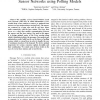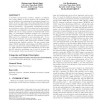11 search results - page 2 / 3 » On the design of uplink and downlink group-orthogonal multic... |
ICC
2007
IEEE
13 years 11 months ago
2007
IEEE
—Uplink-Downlink imbalance is a characteristic of all wireless networks which greatly impacts system performance, and must be accounted for in system design and simulation. Howev...
MOBICOM
2012
ACM
11 years 7 months ago
2012
ACM
Current wireless network design is built on the ethos of avoiding interference. In this paper we question this long-held design principle. We show that with appropriate design, su...
MSWIM
2005
ACM
13 years 10 months ago
2005
ACM
This work describes a detailed simulation-based study of the performance of an IEEE 802.11e Medium Access Control (MAC) layer over an IEEE 802.11g Physical (PHY) layer. The study ...
WIOPT
2010
IEEE
13 years 3 months ago
2010
IEEE
—We consider a Ferry based Wireless Local Area Network (FWLAN), in which information is forwarded from a base station to sensors, or gathered from sensors to a base station using...
IWCMC
2009
ACM
13 years 11 months ago
2009
ACM
In wireless communication systems, adaptive modulation and coding (AMC) is used to improve the downlink (DL) spectral efficiency by exploiting the underlying channel condition. Ho...


